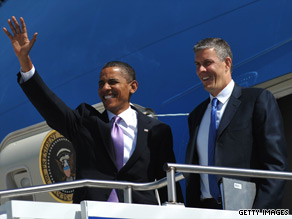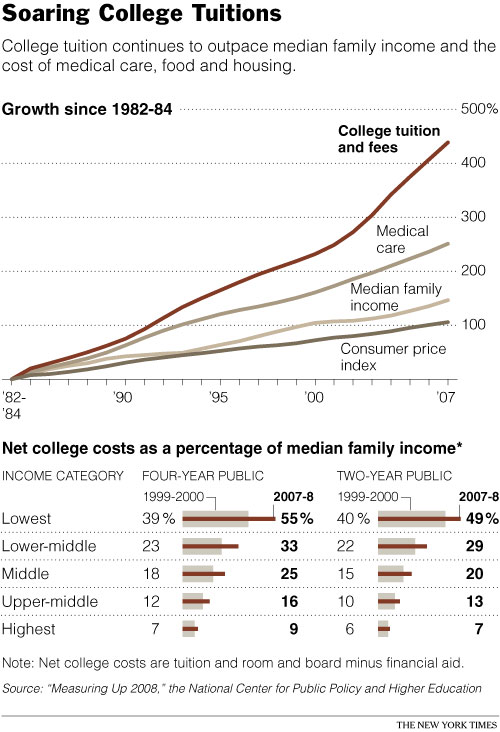Obama's "Fighting for Scraps: Higher Ed Edition!" (Updated)
 As anyone with an eye on the world of electoral politics has seen, because this is an election year we've been seeing "Candidate Obama" much more often. The Candidate Obama stage is about the only time the Democrats' liberal base gets a few bones thrown to it (it's a shame he wasn't up for re-election in 2010 - we might have gotten a halfway decent healthcare bill).
As anyone with an eye on the world of electoral politics has seen, because this is an election year we've been seeing "Candidate Obama" much more often. The Candidate Obama stage is about the only time the Democrats' liberal base gets a few bones thrown to it (it's a shame he wasn't up for re-election in 2010 - we might have gotten a halfway decent healthcare bill).
In a bid to re-energize the university student vote, President Obama made quite a few pledges and proposals around higher ed in his State of the Union Address. The crux:
Join me in a national commitment to train two million Americans with skills that will lead directly to a job. My Administration has already lined up more companies that want to help. Model partnerships between businesses like Siemens and community colleges in places like Charlotte, Orlando, and Louisville are up and running. Now you need to give more community colleges the resources they need to become community career centers – places that teach people skills that local businesses are looking for right now, from data management to high-tech manufacturing. [...]
When kids do graduate, the most daunting challenge can be the cost of college. At a time when Americans owe more in tuition debt than credit card debt, this Congress needs to stop the interest rates on student loans from doubling in July. Extend the tuition tax credit we started that saves middle-class families thousands of dollars. And give more young people the chance to earn their way through college by doubling the number of work-study jobs in the next five years.
Of course, it's not enough for us to increase student aid. We can't just keep subsidizing skyrocketing tuition; we'll run out of money. States also need to do their part, by making higher education a higher priority in their budgets. And colleges and universities have to do their part by working to keep costs down. Recently, I spoke with a group of college presidents who've done just that. Some schools re-design courses to help students finish more quickly. Some use better technology. The point is, it's possible. So let me put colleges and universities on notice: If you can't stop tuition from going up, the funding you get from taxpayers will go down. Higher education can't be a luxury – it's an economic imperative that every family in America should be able to afford.
A few thoughts.
More federal financial aid is good — but not great. It's a good idea to hold down the interest rate for Federally-subsidized loans, but that will cost big bucks, and the GOP-held House will never pass it. But in general, Federal loans and grants are becoming a laughably small portion of the total loans that students are taking out for college. If Obama wanted to capture the enthusiasm of not just students but the recently-graduated (who also, if they turn out, tend to vote overwhelmingly Democratic) he would propose lifting the unconscionable restrictions on student loan dischargement — allow people to erase some or all of their student debt through bankruptcy.
The carrot/stick approach to tuition control won't work. After the SOTU, Obama's been on a speaking tour, elaborating on the proposals offered Tuesday night. This morning at the University of Michigan, we got a few more details.
“The campus-based aid that the federal government provides to colleges through Supplemental Educational Opportunity Grants (SEOG), Perkins Loans, and Work Study is distributed under an antiquated formula that rewards colleges for longevity in the program and provides no incentive to keep tuition costs low,” the White House said in a news briefing statement. “The President is proposing to change how those funds are distributed by implementing an improved formula that shifts aid from schools with rising tuition to those acting responsibly, focused on setting responsible tuition policy, providing good value in education, and ensuring that higher numbers of low-income students complete their education. [...]
[Sec. of Education Arne] Duncan said holding the line for tuition increases by universities means not raising tuition over the pace of inflation. Most of Michigan’s universities have not matched that in recent years, but have said they have to raise tuition to make up for cuts in state aid.
State legislators have said they have had their hands tied by the slumping economy.
But Duncan wasn’t buying that as an excuse.
 It's not an excuse. It's the truth. What the Administration is proposing is to punish state universities that are unaffordable — by making them even more unaffordable. It's hard to imagine a more backward way of "addressing" the problem, which is partly a reflection of how impotent the Federal government is when dealing with this kind of complex issue.
It's not an excuse. It's the truth. What the Administration is proposing is to punish state universities that are unaffordable — by making them even more unaffordable. It's hard to imagine a more backward way of "addressing" the problem, which is partly a reflection of how impotent the Federal government is when dealing with this kind of complex issue.
There are also internal institutional incentives for raising university tuition, and their prominence is due to the fact that the people bearing the cost are the ones furthest from the levers of power (the students themselves). The University of California system loves a dollar of tuition more than a dollar of state funding, because the promise of tuition dollars can be used as loan collateral when the Regents go on their Massive Unnecessary Construction Project of the Week™.
State schools all across the country have realized that by pumping up tuition and private donors (from alumni to defense contractors) they can avoid the pesky restrictions that are placed on state-issued funds. And of course cash-strapped state legislatures are all too happy to go along.
Many private schools for the past 25 years have conducted a veritable tuition arms race with each other, based on what's called the "Chivas Regal Effect" (named for the once-obscure brand of Scotch that boosted sales and prominence by dramatically increasing its price). As Erik Larson put it more than a decade ago in his great dissection of ivy-league tuition intrigue:
In the '80s a new ethos evolved among university officials--and parents--that equated price with quality. A collateral force ensured that tuition would not only rise but also rise at the same rate for comparable schools. Colleges in the Ivy League have always kept close watch on one another, setting their tuition to make sure no one school became so much of a bargain that it drew the best students just on the basis of price. Less prestigious schools set their prices in relation to what the Ivies charged. Says Meyerson: "We were building up a kind of notion about colleges and universities that the higher the price, the better they were."
More recently, Malcolm Harris in his excellent essay connecting the tuition and housing bubbles writes:
Since 1978, the price of tuition at US colleges has increased over 900 percent, 650 points above inflation. To put that number in perspective, housing prices, the bubble that nearly burst the US economy, then the global one, increased only fifty points above the Consumer Price Index during those years.
Until and unless we change the institutional structure of universities, we're never going to get these costs anywhere out of the stratosphere.
The carrot/stick approach to college graduation rates won't work. That is to say, it may superficially work in increasing the raw percentage of degree-holding graduates, but there are myriad ways colleges can game that system:
- Poor and students deemed at risk of dropping out will simply be denied admission in the first place.
- Curricula will be dumbed down on orders from the administration, along with applying even more pressure on professors to not fail students. (I could easily see departments given "graduation quotas" to meet, by hook or by crook.)
- "At-risk" students will be diverted into poor quality Associate's Degree programs.
- Harsher financial penalties for those who drop out or transfer, to make up for the loss of Federal dollars (e.g. scholarships contingent upon successful degree completion, so if you have to drop out or take a leave of absence your third year, you're all of a sudden on the hook for the full price of tuition for the last three years).
- We'll see outright fraud, misreporting, and other "creative accounting" techniques to either give students worthless degrees just to push them across the stage at graduation, or just lie about how many dropped out.
I didn't just pull these techniques out of thin air. They're being used all the time already, across the country, to cope with another set of onerous Federal student achievement/graduation requirements: No Child Left Behind and Race to the Top. (You can catch up on this entirely expected failure of neoliberal education "incentivizing" here - and read about the folly of high-stakes numerical evaluation here.)
In K-12, and now in higher education, the government is ignoring the actual reasons why students fall through the cracks (or simply jump a sinking ship, depending). And, like the question of tuition, once again it's a result of those most affected by poor quality education having the least say.
At some point we're going to churn through enough doomed policy proposals from Washington, DC that even the wonkiest of education advocates will realize we need to make structural changes to how our institutions of education are run — to make them more democratic. Hopefully by then, the rest of us will have been busy organizing and winning that goal without them.
UPDATE: For extra lulz, read about how Rick Santorum thinks Obama's higher ed emphasis is due to the President's desire to brainwash our nation's helpless children into being fellow atheist-Muslim-fascist-communists: "The indoctrination that occurs in American universities is one of the keys to the left's holding and maintaining power in America."
UPDATE II: Claire Potter over at The Chronicle has a great piece on this, explaining exactly who was (and more importantly, who wasn't) at the table when Obama figured out his plan in December, and offering better points of inquiry for real higher ed policy at the state and federal level.